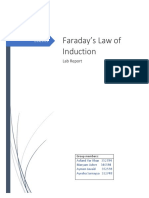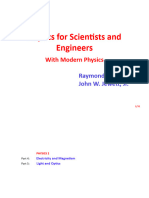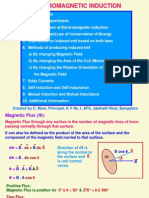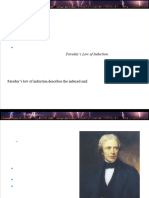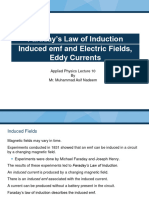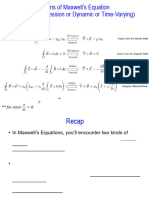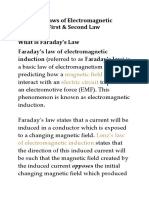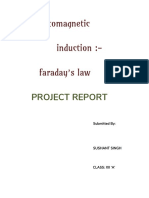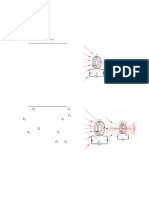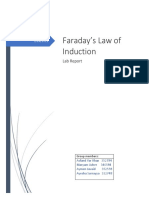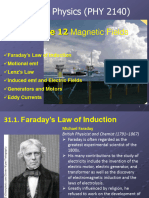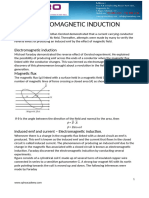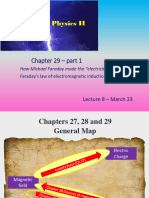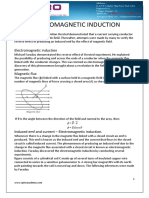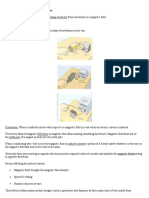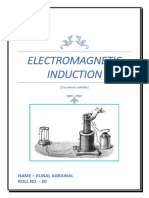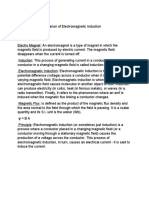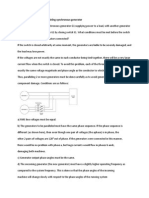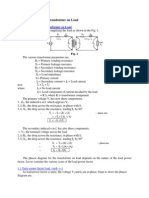0 ratings0% found this document useful (0 votes)
10 viewsFaraday Laws
Faraday Laws
Uploaded by
Adnan KhanFaraday's laws of electromagnetic induction describe how a changing magnetic field can induce an electromotive force (emf) in a conductor.
Faraday's first law states that any change in the magnetic field around a coil of wire will induce an emf in the coil. The second law states that the magnitude of the induced emf is proportional to the rate of change of the magnetic flux through the coil.
The rate of change of magnetic flux linkage is equal to the induced emf, according to Faraday's law of electromagnetic induction.
Copyright:
© All Rights Reserved
Available Formats
Download as DOCX, PDF, TXT or read online from Scribd
Faraday Laws
Faraday Laws
Uploaded by
Adnan Khan0 ratings0% found this document useful (0 votes)
10 views2 pagesFaraday's laws of electromagnetic induction describe how a changing magnetic field can induce an electromotive force (emf) in a conductor.
Faraday's first law states that any change in the magnetic field around a coil of wire will induce an emf in the coil. The second law states that the magnitude of the induced emf is proportional to the rate of change of the magnetic flux through the coil.
The rate of change of magnetic flux linkage is equal to the induced emf, according to Faraday's law of electromagnetic induction.
Copyright
© © All Rights Reserved
Available Formats
DOCX, PDF, TXT or read online from Scribd
Share this document
Did you find this document useful?
Is this content inappropriate?
Faraday's laws of electromagnetic induction describe how a changing magnetic field can induce an electromotive force (emf) in a conductor.
Faraday's first law states that any change in the magnetic field around a coil of wire will induce an emf in the coil. The second law states that the magnitude of the induced emf is proportional to the rate of change of the magnetic flux through the coil.
The rate of change of magnetic flux linkage is equal to the induced emf, according to Faraday's law of electromagnetic induction.
Copyright:
© All Rights Reserved
Available Formats
Download as DOCX, PDF, TXT or read online from Scribd
Download as docx, pdf, or txt
0 ratings0% found this document useful (0 votes)
10 views2 pagesFaraday Laws
Faraday Laws
Uploaded by
Adnan KhanFaraday's laws of electromagnetic induction describe how a changing magnetic field can induce an electromotive force (emf) in a conductor.
Faraday's first law states that any change in the magnetic field around a coil of wire will induce an emf in the coil. The second law states that the magnitude of the induced emf is proportional to the rate of change of the magnetic flux through the coil.
The rate of change of magnetic flux linkage is equal to the induced emf, according to Faraday's law of electromagnetic induction.
Copyright:
© All Rights Reserved
Available Formats
Download as DOCX, PDF, TXT or read online from Scribd
Download as docx, pdf, or txt
You are on page 1of 2
Faraday's Laws
Faraday's First Law
Any change in the magnetic field of a coil of wire will cause an emf to be induced in the coil.
This emf induced is called induced emf and if the conductor circuit is closed, the electric current
will also circulate through the circuit and this electric current is called induced current.
Method to change magnetic field:
1. By moving a magnet towards or away from the coil
2. By moving the coil into or out of the magnetic field.
3. By changing the area of a coil placed in the magnetic field
4. By rotating the coil relative to the magnet.
Faraday's Second Law
It states that the magnitude of emf induced in the coil is equal to the rate of change of flux that
linkages with the coil. The flux linkage of the coil is the product of number of turns in the coil
and flux associated with the coil.
Faraday Law Formula
Faraday's law
Consider a magnet approaching towards a coil. Here we consider two instants at time T
1
and
time T
2
.
Flux linkage with the coil at time, T
1
= N
1
Wb
Flux linkage with the coil at time, T
2
= N
2
wb
Change in flux linkage = N(
2
-
1
)
Let this change in flux linkage be, =
2
-
1
So, the Change in flux linkage = N
Now the rate of change of flux linkage = N / t
Take derivative on right hand side we will get
The rate of change of flux linkage = Nd/dt
But according to Faraday's law of electromagnetic induction, the rate of change of flux linkage is
equal to induced emf.
Considering Lenz's Law.
Where flux in Wb = B.A
B = magnetic field strength
A = area of the coil
You might also like
- Faraday's Law of Induction: Lab ReportDocument8 pagesFaraday's Law of Induction: Lab ReportAymen JavaidNo ratings yet
- Elmachi1 - Lecture6 (Electrical Machines - Part 1)Document17 pagesElmachi1 - Lecture6 (Electrical Machines - Part 1)Trisha SARMIENTONo ratings yet
- Faraday Law of Electromagnetic InductionDocument5 pagesFaraday Law of Electromagnetic Inductionantex nebyuNo ratings yet
- Chap31 HungDocument43 pagesChap31 Hung23128002No ratings yet
- Faraday's Electeomagnetic Induction.Document5 pagesFaraday's Electeomagnetic Induction.Rajesh JagadeesanNo ratings yet
- Magnetic Induction: Faraday and Lenz'S Lawg HB J YDocument26 pagesMagnetic Induction: Faraday and Lenz'S Lawg HB J YIrah Arienza MarandacanNo ratings yet
- Electromagnatic InductionDocument2 pagesElectromagnatic InductionSouvik ChakrabortyNo ratings yet
- 1 Electromagnetic InductionDocument20 pages1 Electromagnetic InductionRizan SaopNo ratings yet
- Laws Governing Magnetic Circuits PDFDocument2 pagesLaws Governing Magnetic Circuits PDFVenkata SubramanianNo ratings yet
- Physics TheoryDocument6 pagesPhysics Theorylalit palNo ratings yet
- ELECTROMAGNETISMDocument18 pagesELECTROMAGNETISMVaibhaviNo ratings yet
- Module2 Lesson3Document5 pagesModule2 Lesson3Jerald AlvaradoNo ratings yet
- Faraday's LawDocument5 pagesFaraday's LawSyeda Rutab AzizNo ratings yet
- Chapter 31Document39 pagesChapter 31Aranyaman MohanNo ratings yet
- Faraday Law of Induction, Induced Emf and Electric Field, Eddy CurrentDocument17 pagesFaraday Law of Induction, Induced Emf and Electric Field, Eddy Currentzaini.iqbal761No ratings yet
- NotesDocument55 pagesNotesdhonims2367No ratings yet
- FARADAYDocument6 pagesFARADAYoseisilasyawNo ratings yet
- Electromagnetic Induction NOtesDocument76 pagesElectromagnetic Induction NOtesashunaik409No ratings yet
- Faraday's LawDocument9 pagesFaraday's LawaliNo ratings yet
- Electromagnetic InductionDocument13 pagesElectromagnetic InductionRanjit SinghNo ratings yet
- 1 Electromagnetic InductionDocument20 pages1 Electromagnetic InductionHarmanjeet SinghNo ratings yet
- Electromagnetic InductionDocument18 pagesElectromagnetic InductionShailesh MishraNo ratings yet
- ECEN 322 Module8 Maxwell's Equations p2 - Faraday's LawDocument29 pagesECEN 322 Module8 Maxwell's Equations p2 - Faraday's Lawzhenhaoli50No ratings yet
- FaradayDocument14 pagesFaradayVarad KakodkarNo ratings yet
- Created by C. Mani, Principal, K V No.1, AFS, Jalahalli West, BangaloreDocument20 pagesCreated by C. Mani, Principal, K V No.1, AFS, Jalahalli West, BangaloreShreya Chakroverty ChoudharyNo ratings yet
- Electromagnetic Induction ExplainedDocument3 pagesElectromagnetic Induction ExplainedAli HamzaNo ratings yet
- Chapter 5 Magnetic Induction Final 1Document52 pagesChapter 5 Magnetic Induction Final 1Salve Marie DoratoNo ratings yet
- Physics ProjectDocument15 pagesPhysics ProjectDebkanti Gupta Bhaya0% (1)
- Presentation (Autosaved)Document17 pagesPresentation (Autosaved)Muhammad Hamza Mujeeb AhmadNo ratings yet
- Electromagnetic Induction (Physics) : Magnetic Flux & Faraday&apos S Law of InductionDocument15 pagesElectromagnetic Induction (Physics) : Magnetic Flux & Faraday&apos S Law of InductionistudyNo ratings yet
- Electomagnetic Induction:-Faraday's Law: Project ReportDocument17 pagesElectomagnetic Induction:-Faraday's Law: Project ReportSushantSinghNo ratings yet
- 2nd PU part BDocument160 pages2nd PU part BSahana DesaiNo ratings yet
- Electromagnetic InductionDocument9 pagesElectromagnetic Inductionujjwal gowdaNo ratings yet
- Faraday's Law of Induction: Lab ReportDocument8 pagesFaraday's Law of Induction: Lab ReportAymen JavaidNo ratings yet
- Lecture 12Document42 pagesLecture 12dang.phamNo ratings yet
- Q4 General Physics 2 STEM 12 Week 1Document38 pagesQ4 General Physics 2 STEM 12 Week 1Personal AccountNo ratings yet
- Physics Faraday ProjectDocument16 pagesPhysics Faraday ProjectAlviya Rizwan100% (1)
- Introduction To Magnetic CircuitsDocument23 pagesIntroduction To Magnetic Circuitssharad kumarNo ratings yet
- 4 Electromagnetic Induction & Alternating CurrentsDocument42 pages4 Electromagnetic Induction & Alternating CurrentsNathanianNo ratings yet
- electromagnetic-inductionDocument23 pageselectromagnetic-inductionsolomonakhulunyaNo ratings yet
- Lecture 18 - Chapter 29 Part 1Document20 pagesLecture 18 - Chapter 29 Part 1Mircea PanteaNo ratings yet
- Phy104 Electricity and Magnetism 5Document12 pagesPhy104 Electricity and Magnetism 5kadebiyiojoNo ratings yet
- Electromagnetic Induction CH6Document18 pagesElectromagnetic Induction CH6Rishab SharmaNo ratings yet
- Electromagnetic Induction and Alternating CurrentDocument31 pagesElectromagnetic Induction and Alternating CurrentsunliasNo ratings yet
- Phy2 11 - 12 Q4 0902 PF FD 2Document47 pagesPhy2 11 - 12 Q4 0902 PF FD 2Jeremie Silawan MagalingNo ratings yet
- 1 Chapter Magnetic CircuitDocument31 pages1 Chapter Magnetic CircuitSwayam VyasNo ratings yet
- Electromagnetic InductionDocument21 pagesElectromagnetic InductionParth GuptaNo ratings yet
- Induced EMFDocument21 pagesInduced EMFJaica Mangurali TumulakNo ratings yet
- Production of Induced Emf and Magnetic FluxDocument44 pagesProduction of Induced Emf and Magnetic FluxDivakar kumar JhaNo ratings yet
- Electromagnetic Induction: Name - Kunal Agrawal Roll No. - 20Document22 pagesElectromagnetic Induction: Name - Kunal Agrawal Roll No. - 20Kunal AgrawalNo ratings yet
- 9 - Chapter-9 Faraday's LawDocument17 pages9 - Chapter-9 Faraday's Lawshaikatroy25800No ratings yet
- ElectroMagnetic InductionDocument8 pagesElectroMagnetic InductionRobin Singh100% (1)
- Electromagnetic InductionDocument21 pagesElectromagnetic InductionEs ENo ratings yet
- Physics ProjectDocument8 pagesPhysics ProjectVanshika DariraNo ratings yet
- Chapter 3 EMIDocument52 pagesChapter 3 EMIMayank MeghaniNo ratings yet
- Physics Investigatory ProjectDocument15 pagesPhysics Investigatory ProjectRaj SharmaNo ratings yet
- LRL Accelerators, The 184-Inch SynchrocyclotronFrom EverandLRL Accelerators, The 184-Inch SynchrocyclotronNo ratings yet
- Feynman Lectures Simplified 2C: Electromagnetism: in Relativity & in Dense MatterFrom EverandFeynman Lectures Simplified 2C: Electromagnetism: in Relativity & in Dense MatterNo ratings yet
- Negative Mass and Negative Refractive Index in Atom Nuclei - Nuclear Wave Equation - Gravitational and Inertial Control: Part 3: Gravitational and Inertial Control, #3From EverandNegative Mass and Negative Refractive Index in Atom Nuclei - Nuclear Wave Equation - Gravitational and Inertial Control: Part 3: Gravitational and Inertial Control, #3No ratings yet
- Conditions Required For ParallelingDocument1 pageConditions Required For ParallelingAdnan KhanNo ratings yet
- PMDC MotorDocument2 pagesPMDC MotorAdnan KhanNo ratings yet
- Phasor Diagrams For Transformer On LoadDocument3 pagesPhasor Diagrams For Transformer On LoadAdnan KhanNo ratings yet
- Phasor Diagrams For Transformer On LoadDocument3 pagesPhasor Diagrams For Transformer On LoadAdnan KhanNo ratings yet
- PMDC MotorDocument2 pagesPMDC MotorAdnan KhanNo ratings yet
- Losses in TransformerDocument2 pagesLosses in TransformerAdnan KhanNo ratings yet
